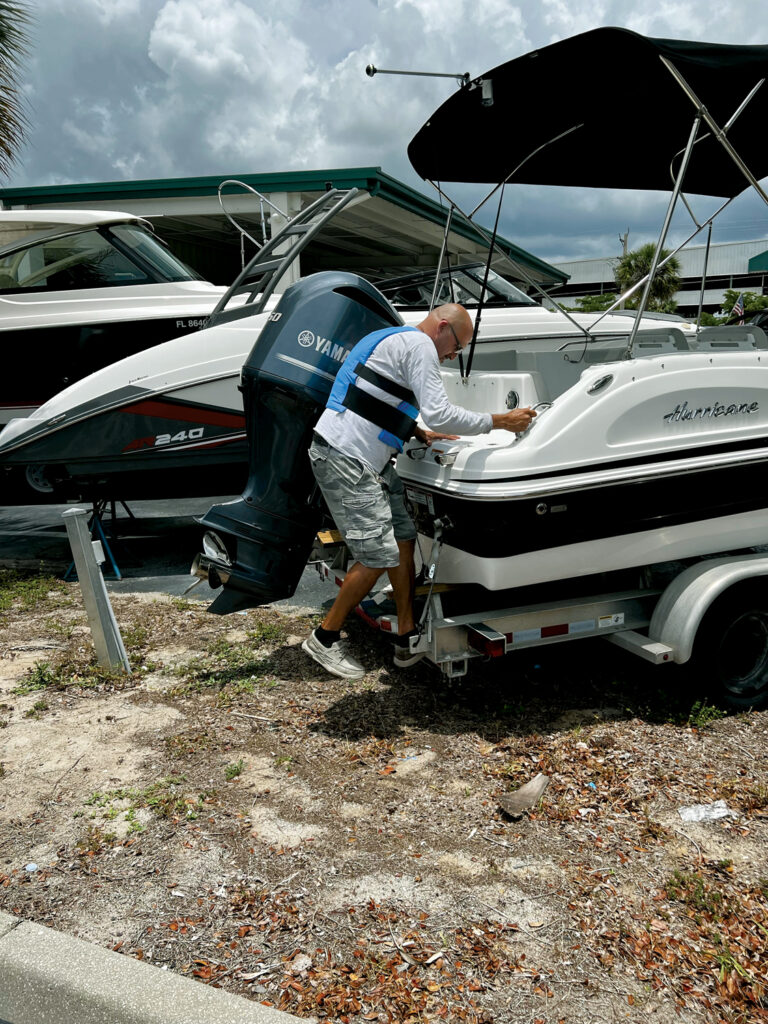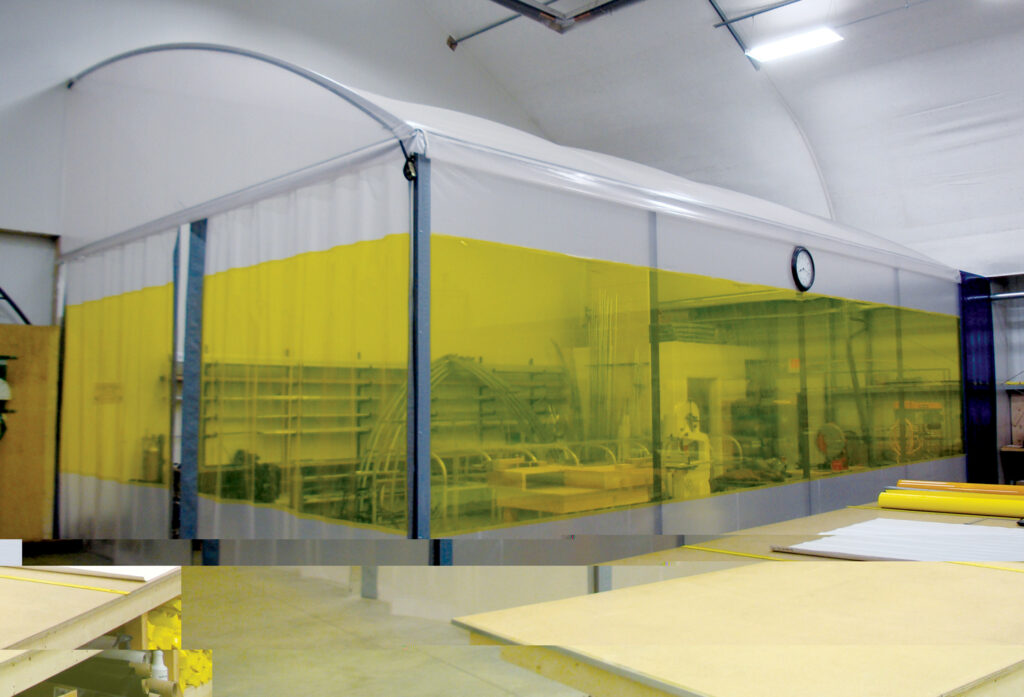Safety practices at the marina and in the shop

It was late in the day, rain was threatening, and Edward Skrzynski needed to cover a boat that was on an elevator lift before the storm hit. All the available workers were out, so telling no one he was leaving, he headed out to handle the task alone. Just as he arrived, it started drizzling. Climbing onto the boat after removing his shoes, he made his way to the (freshly waxed) bow with the cover. Standing there, he lost his footing and started sliding toward the bow rail at a speed that made going overboard
a certainty.
“I knew the boat lift’s 12-inch metal I-beams were directly below where I was going off, and all I could think about was hitting my head and passing out in the water,” recalls Skrzynski, owner of Marco Canvas & Upholstery LLC in Marco Island, Fla.
“As I slid towards the rail, I held the top rail with my right hand and did a 180 over it, still keeping hold of the rail as I slammed into the side of the boat,” he continues. “I looked down and saw that I was clear of the metal and dropped into the water.”
Skrzynski swam to an emergency dock ladder but struggled to get back on land because he couldn’t lift his arm. Although the acrobatics he performed saved him from something worse, he had ripped the tendons in his shoulder.
“From then on, I said ‘no more’ to solo trips no matter how small the work is,” he says. “There needs to be someone for backup and to help. Also no work on rigs in the rain. Too slippery. Not worth it. Anyone leaving the shop must inform senior management prior to departure. And on-site we must always have two people and two phones as a backup.”
As illustrated, the marine environment offers many hazards, where even the most routine work can quickly turn dangerous. Here’s how some fabricators keep themselves and their employees safer whether on a boat or in the shop.

On a vessel
Aaron Stroud, owner of Canvas Barn Marine Trimming (CBMT), says slippery surfaces pose the biggest threat on a vessel, which is why workers dry off boats with towels before starting to work. Located in Swan Reach, Victoria, Australia, CBMT is a full-service provider of custom exterior and interior covers, cushions, lining and flooring. Stroud also surveys vessels for any trip hazards and ensures there are no electrical leads dangling in the water.
Other safety measures include putting chemicals in small containers to reduce the chance of spilling large amounts into the environment and vacuuming up drilling debris to keep contaminants out of the water. On boats likely to shift as people move around, explains Stroud, employees are instructed to communicate before doing so, giving others aboard the opportunity to hold on to something.
As vessels have gotten taller, heights are presenting a greater safety risk, Stroud says. Consequently, harnesses and fall ropes are becoming more common. John McMahon, president of Scandia Canvas Works & Sail Loft, says his company uses harnesses when necessary and will also ask a customer to change the vessel’s position in the slip so his team can work with greater safety. Located in Sturgeon Bay, Wis., the full-service shop provides custom canvas solutions, upholstery and repairs along with designing and selling new sails and repairing old ones.

Tumbling into the frigid waters of Lake Michigan is a big concern, he says, as is falling on concrete if the boat is “on the hard.” But among the riskiest situations are those posed by difficult-to-access spots.
“I feel like we need to make the owners/boat dealers provide us with a safer way to reach certain boat areas,” McMahon says. “If you’ve ever been in a winter boat storage facility, you know they are packed in like sardines. This also creates risks like getting onto the boat and hitting your head on an anchor from the boat behind because they are stored so closely together.”
Most of Custom Canvas Alaska LLC’s boat work happens indoors, says Devlin McKee, owner. Located in Fairbanks, Alaska, the shop provides custom boat tops and accessories, as well as portable shelters and arctic covers for vehicles and heavy equipment.
When working on boats indoors, the team constructs scaffolding around the vessel to create a wider platform, says Devlin, making sure to keep sufficient clearance around it and that all the proper installation tools are right at hand. Another safety measure involves scissors.

“Early in our business, scissors were carried around in pockets and not properly attached to the fabricator,” he explains. “This increased the possibility of puncture wounds or loss of equipment, so we created a holster to be worn on a belt by every fabricator. The holster locks the scissors in place so it doesn’t fall out.”
Marco Canvas, which provides custom shades, marine canvas and outdoor upholstery to multiple markets and also offers a patented product line for retractable mooring covers, uses a digital automation process to help reduce the time workers spend in the field, minimizing the opportunities for accidents, says Skrzynski.
When fabricators do venture onboard, they rely on a “preflight safety plan,” making sure all the right tools—ladders, planks, floats, life jackets, eyewear, water, lightning detectors (“Florida is the lightning capital of the U.S.,” he says) and so on—are at hand. The team is also always watching out for one another, he adds.

In the shop
New hires at Marco Canvas are closely monitored and paired with skilled staff to help ward off any “rookie mistakes,” says Skrzynski. They also receive safety protocol training and must sign that they received and reviewed a copy of the safety standard operating procedure. Personal protective equipment (PPE) is provided for every type of job, with eye protection “almost always” required. When working with items overhead, hard hats are worn.
Although a sewing shop is loaded with potentially dangerous equipment, Skrzynski has found that more accidents are caused by slips and falls and dropped items (along with small cuts from shears, needles and razors). Thus, organization and adopting an “everything in its place” attitude is essential, he says.
“It’s easy to get messy in smaller spaces, and time must be added to keep everything organized or keep items out of walking aisles or piled onto tables. It’s a daily battle,” says Skrzynski, adding that many accidents happen from simply not picking up.

It’s the same for Stroud—a clean workshop environment is a safe environment. CBMT keeps things tidy by putting scraps directly into trash cans strategically placed around the shop. Air lines and electrical leads are hung up so as not to cause tripping. The appropriate PPE is required when working with power tools. When using glues/solvents, the area is well ventilated and fans move the fumes away from the work area.
“We have a low fire risk, as smoking is not permitted on-site,” Stroud says. “However, there are multiple fire extinguishers in the workshop; personnel are never more than 12 feet from an extinguisher at any time. There is also a fully equipped first aid kit in the workshop and another in the work pickup.”
McMahon says safety is a “constant” in his shop, issuing daily reminders to “be safe out there.” The team members maintain a complete first aid kit, keep their tools and scissors sharp, regularly change needles, replace roller cutter blades and so on. PPE is required depending on the job, safety meetings and training are held, and shop cleanliness is emphasized.
“We reinforce awareness and work at an efficient but safe pace on all projects to avoid the potential for injury,” he says. “We have 21 steps leading up to our shop and if you’re carrying an item that limits visibility, it could be a disaster. We encourage teamwork when it comes to bringing up or taking down projects.”

Custom Canvas reinforces safety through training and monthly meetings where staff is encouraged to bring up any concerns, says McKee. Policies on proper attire (including “sensible shoes”), the use of scissor holsters, tool maintenance and PPE are in effect. Other safety measures include a noise-dampening area for metalwork, first aid kits, fire extinguishers and ventilation.
“We keep our crew safe with signage and awareness, cleanliness and PPE, training and communication,” says McKee, who relies on federal and state websites for accurate signage. “Sometimes people are not as accepting of change, but once the procedure is explained as to why it has changed, people are more receptive.”
Skrzynski stresses the value of getting an outside assessment, suggesting that shop owners invite their workers’ comp representative or someone from the Occupational Safety and Health Administration (OSHA) to come in and conduct a safety study.
“Many of us feel like we are safe enough as we cannot clearly see the issues around us. I’d encourage a fresh set of eyes. Human nature is to grow complacent until something bad happens,” he says. “Then we are smacked with the need to change.”
Pamela Mills-Senn is a freelance writer based in Seal Beach, Calif.
SIDEBAR: Additional safety hacks
“Provide space for storage of assigned tools (lockers or cubbies). Provide plenty of eye and ear protection in multiple areas. Have open communication with everyone in your crew so expectations are known and practiced.”
Devlin McKee, Custom Canvas Alaska LLC
“Make safety a part of your culture; instill safety as often as possible. Just because you said it once doesn’t mean they remember. And don’t forget new staff—it should be part of their onboarding.”
John McMahon, Scandia Canvas Works & Sail Loft
“UV is extreme here in the subtropics. Shade, long-sleeved UV-blocking and fast-drying shirts, big hats, polarized and UV-blocked sunglasses, UV face masks as well as sunblock are part of our PPE supplies. Heatstroke is real and the more comfortable you are, the longer and better you can work in the sun and heat.”
Edward Skrzynski, Marco Canvas & Upholstery LLC
“There are plenty of resources to help get your workshop to a safe and legal level. It’s well worth looking at how your workspace can be safer. More often than not, the measures taken also improve productivity, making it a win-win.”
Aaron Stroud, Canvas Barn Marine Trimming
 TEXTILES.ORG
TEXTILES.ORG 






